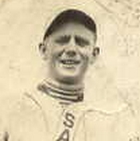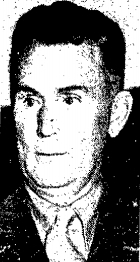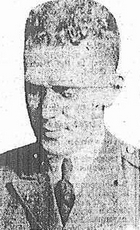Dick Aldworth
| Date and Place of Birth: | October 1, 1897 Augusta, GA |
| Date and Place of Death: | September 18, 1943 Kelly Field, San Antonio, TX |
| Baseball Experience: | Minor League |
| Position: | Pitcher |
| Rank: | Colonel |
| Military Unit: | USAAF |
| Area Served: | Europe and United States |
Dick Aldworth was a semi-pro star in San Antonio before going to spring training with the Philadelphia Athletics. His minor league career was interrupted by World War II and he served as a fighter pilot on the Western Front. Aldworth remained in military service for 22 years and returned in 1941, to help his friend, Claire Chennault form the Flying Tigers.
Richard T. “Dick” Aldworth, the son of Thomas and Agness Aldworth, was
born on October 1, 1897, in Augusta, Georgia. His father died on April
25, 1906,
and Richard and his mother moved to San Antonio, Texas, to live with her
parents, James and Katherine Quinn.
Aldworth attended St. Anthony's Apostolic School (commonly known as St.
Anthony's College) - where he was an outstanding pitcher - and
attended St. Mary's University in San Antonio in 1914.
By the time of his graduation, Aldworth was a well-known figure within
the San Antonio baseball community. The tall, redhead, who played
baseball for the Knights of Columbus and hurled a two-hitter against the
Signal Corps team at nearby Fort Sam Houston in April of that year, was
signed by Connie Mack’s Philadelphia Athletics in October 1915. To
celebrate, he hurled a 5-0 no-hitter against the Harlandales, for the
Ahrens & Ott semi-pro team on Oct 31, and spent the winter months
captaining the Knights of Columbus basketball team before reporting to
the Athletics’ spring training camp at Jacksonville, Florida, in March
1916.
Aldworth was used sparingly during spring training, but turned in a
solid performance in April against the University of Tennessee. Hurling
eight innings before the game was halted due to rain, Aldworth beat the
Volunteers, 6-0, allowing just one hit and fanning 13.
When the regular season opened, Aldworth was assigned to the New Haven
Murlins of the Class B Eastern League. Managed by former Athletics
second baseman, Danny Murphy, and playing alongside big leaguers Rube
Bressler, Frank Woodward, Dizzy Nutter, Red Shannon and Mickey Devine,
Aldworth made nine appearances for a 4-4 won-loss record with 64 innings
pitched. By July, however, at a time when the Athletics could have used
a decent pitcher (they were 19 and 71 by the end of July and finished
the season with an abysmal 36-117 record), Aldworth was back home in San
Antonio, nursing a sore arm.
By the time the 1917 baseball came around, America had entered the First
World War, and Aldworth had enlisted at Fort Sam Houston in San Antonio,
Texas. His professional baseball days were behind him but he was still
playing, albeit with the Army’s headquarters team at Fort Sam
Houston, causing as much damage with his bat as with his pitching. On
April 29, Aldworth had a home run, two triples and two singles in a 21-3
thrashing of the Aeros at Fort Sam Houston. In May 1917, he attended the School of Military Aeronautics at
the University of Texas, Austin, for ground flight instruction with a
view to becoming a pilot. He went on to train with the Aviation Section
of the Signal Corps at Fort Wood, New York, until October 1917, then
left the United States for France, and learned to fly with the
Headquarters Detachment, 3rd Aviation Instruction Center at Issoudun
Aerodrome. Aldworth soloed in two hours and 35 minutes in December 1917.
From France, he went to Italy and continued to train at the 8th Aviation
Instruction Center in Foggia, also teaching Italian pilots to fly (Italy
was an ally during the First World War).
In July 1918, Lieutenant Aldworth joined the 213th Aero Squadron, 3rd
Pursuit Group, in France, and took part in the St. Miehel, Meuse and
Argonne campaigns. Aldworth flew the French-designed Spad S.VII and Spad
S.XIII biplanes, engaging and clearing German aircraft from the skies
and providing escort to reconnaissance and bombardment squadrons over
enemy territory. He also attacked enemy observation balloons, and
performed close air support and tactical bombing attacks of enemy forces
along the front lines. On November 4, 1918, Lt. Aldworth shot down a
German plane northwest of Verdun, but a few days later he himself was
brought down over German territory and taken prisoner. He managed to
escape from the prisoner-of-war camp in Karlsruhe, Germany, and returned
to allied lines, although news of his safe return did not reach
concerned friends and family in San Antonio until mid-December, up to
which point he had been reported missing in action.
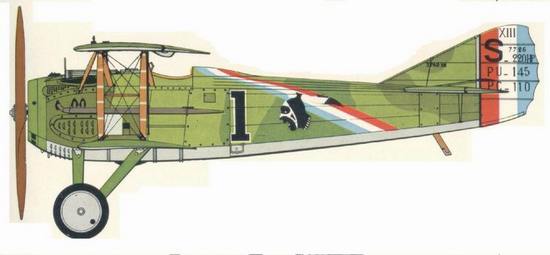
The type of plane Lt. Aldworth flew with the 213th Aero Squadron
With the war over, Aldworth served with the Army of Occupation in
Germany with 138th Aero Squadron. In Coblenz, in July 1919, he was
piloting a Spad biplane for the Polish government who were contemplating
purchasing the plane. Whilst putting the plane through various
maneuvers, the engine failed. Aldworth attempted a landing, but when he
realized he would not be able to clear some fast-approaching trees – and
just a few feet above the ground - he jumped for his life. As the
biplane crashed into the trees and was destroyed, Aldworth landed with a
thud and was lucky to escape with little more than a broken ankle.
Aldworth returned to the United States in September 1919, and remained
in the Air Service. He was stationed at Fort Sam Houston until December,
then moved to Kelly Field - at that time the center for advanced
training, where Claire Chennault of “Flying Tigers” fame, was also an
instructor. During the 1920s, while in service, Aldworth continued to
play baseball in the San Antonio area with the San Antonio Independents
and the Alamo-Peck Indians.
On July 11, 1922, Aldworth suffered further injuries as a result of a
flying accident. He was piloting a two-seater plane at Camp Hancock,
near Augusta, Georgia, that crash-landed due to engine failure. Aldworth
suffered a fractured skull and lacerations to his body, while his
passenger, Major P. E. H. Brainard, received a fractured arm and cuts to
his face.
Yet another accident occurred on December 12, 1926, and on this
occasion, Aldworth’s disregard for his own safety spared the lives of
many others. Taking off from Mitchel Field, Long Island, 1st Lieutenant
Aldworth’s pursuit plane stalled as it was flying towards Rockaway
Beach, Queens. Rather than land on the beach and risk killing civilians,
he ditched the plane in the sea. Despite the plane somersaulting when it
hit the water, Aldworth was able to walk away from the accident with
little more than a scratch on his head.
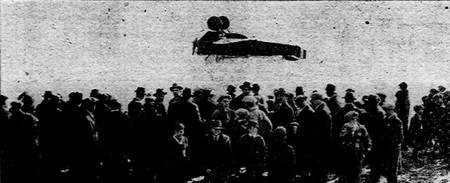
Lt. Aldworth's plane in the water after crashing near
Rockaway Beach, New York, on December 12, 1926.
In January 1929, Aldworth was granted a leave of absence from
military service to act as temporary superintendent at Newark
Metropolitan Airport, having complete authority of all planes flying
from that airfield. His leave expired in July 1929, and he returned to
the air corps, stationed at Langley Field, Virginia. In August 1929,
Aldworth landed at Amboy Airport, near Syracuse, New York, in a Curtiss
P-6 Hawk, to be greeted by H. O. "Bull" Nevin. The two had served
together in France and not seen each other since Aldworth was shot down
behind enemy lines in November 1918. Until then, Nevin believed Aldworth
to be dead.
In January 1930, after 22 years of service, Aldworth retired from active
duty and returned to Newark Metropolitan Airport as supervisor. Not
counting his time in France, Aldworth had had more than 2,800 hours in
the air.
For the next ten years, Aldworth served as supervisor at Newark. On
August 25, 1932, he was on hand at Newark as Amelia Earhart became the
first woman to complete a non-stop transcontinental flight, taking off
from Los Angeles the day before. On November 8, 1934, as official timer
for the National Aeronautical Association, he witnessed Eddie
Rickenbacker break the transcontinental record for transport planes in a
12-hour flight from Burbank, California. On May 9, 1935, he was on hand
to record the official time of Amelia Earhart's non-stop flight from
Mexico City. The 2,100-mile journey took 14 hours, 28 minutes and 50
seconds, covering the perils of the Mexican mountains, the long stretch
of the Gulf of Mexico and up the Atlantic Seaboard. For six years he was
chairman of the New Jersey State Aviation Commission and consultant for
the Bureau of Air Commerce, considered the leading expert on air traffic
control.
On June 5, 1937, in recognition of his act of bravery 11 years earlier
at Rockaway Beach, Aldworth was awarded the Distinguished Flying Cross
in a ceremony at Mitchel Field by Major General Frank R. McCoy,
commanding general of the second corps area.
By 1940, Aldworth was 42 years old, and his health was failing. In 1941,
he was admitted to Walter Reed General Hospital, suffering from
non-Hodgkin lymphoma (cancer of the lymph glands). Despite this, in
April of that year he was called upon to serve his country again. Claire
Chennault was putting together the American Volunteer Force, or “Flying
Tigers”, to help the Chinese fight the Japanese in the air. He
desperately needed to recruit pilots and mechanics. Aldworth was seen as
the perfect person for the job and Chennault telephoned him at Walter
Reed Hospital, explaining the problem and why the group was being
organized. Although gravely ill, Aldworth agreed to help Chennault and
his team.
Between April and December 1941, under the umbrella of the Central
Aircraft Manufacturing Company (CAMCO), Aldworth toured military bases
across the United States to recruit pilots. He interviewed Marines at
Quantico, Navy personnel at Norfolk and San Diego, and Army personnel at
McDill, March, Mitchel, Langley, Hamilton, Eglin, Craig, Maxwell,
Barksdale and Randolph fields. Many pilots had to be interviewed at his
bedside as Aldworth was forced to periodically return to hospital. Over
300 men volunteered to serve with the Flying Tigers.
“Dick Aldworth did a magnificent job,” said Chennault, “although he knew
at the time he took the assignment that his days were numbered.”
In June 1942, Colonel Aldworth returned to San Antonio with the Air
Service Command at Duncan Field. Before being appointed chief of the
maintenance division, he was a technical instructor, special projects
officer, and assistant to the commanding general.
On September 1, 1943, Aldworth’s health dramatically deteriorated. On
September 17, paralyzed and in a sickroom banked with oxygen cylinders,
he gained just enough strength to permit his oxygen tent to be pushed
back, and General Gerald C. Brant awarded Colonel Aldworth the Legion of
Merit for meritorious service in recruiting personnel for the Flying
Tigers. Dick Aldworth died the following day, aged 45.
His Legion of Merit citation reads:
"Richard T. Aldworth, colonel (then first lieutenant, retired), air
corps, United States Army. For exceptionally meritorious conduct in the
performance of outstanding services from April 1941, to December 1941.
Col. Aldworth left the Walter Reed General Hospital in 1941 to undertake
the difficult assignment of selecting competent personnel for the
American Volunteer Group in China (more widely known as the 'Flying
Tigers').
"Despite countless rebuffs and at great detriment to his own health he
utilized his extensive background of service in the army air corps to
carry this arduous task through to a highly successful conclusion.
Activated by the highest patriotic motives, his steadfast devotion to
the cause of a friendly foreign nation proved indirectly of great
benefit to his own country. Col. Aldworth's accomplishments in the
furtherance of the war effort of the United Nations reflect the highest
credit upon himself and the army air forces."
“The death of Col. Richard "Dick" Aldworth,” wrote Harold Scherwitz,
Sports Editor of the San Antonio Light, “touched a responsive note in
the ranks of veteran San Antonio sports followers as the passing of few
men could do. For Aldworth was a sort of Dick Merriwell of local
athletics in the days just preceding World War I.”
George Tucker, who played infield on the Knights of Columbus team for
which Aldworth achieved much of his local fame, called him "one of the
finest, cleanest athletes who ever lived,” and another former teammate
said, “I never saw a better sportsman, a cleaner liver or a better
competitor. He was a remarkable fellow."
Funeral services were held on September 21, 1943, at Kelly Field Chapel
No. 2, by Chaplain Edward Burns, with internment at Fort Sam Houston
National Cemetery. He was survived by his widow, Estelle, and a
daughter, Agness.
|
Year |
Team |
League |
Class |
G |
IP |
ER |
BB |
SO |
W |
L |
ERA |
|
1916 |
New Haven |
Eastern |
B |
9 |
64 |
- |
43 |
- |
4 | 4 |
- |
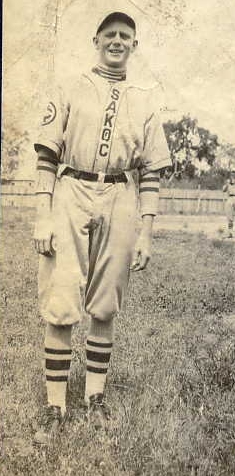
Dick Aldworth in his days with the San Antonio Knights of Columbus team
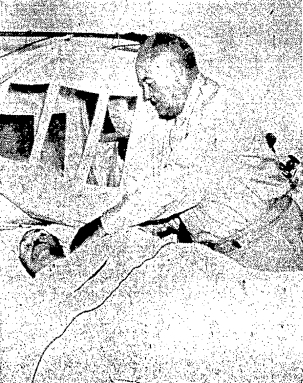
Colonel Aldworth being presented with the Legion of Merit the day before
he died
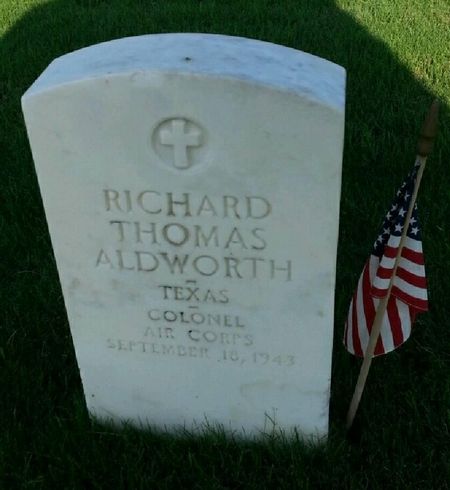
Dick Aldworth's grave at Fort Sam Houston National Cemetery, San
Antonio, Texas
Thanks to Davis O. Barker for "discovering" Dick Aldworth. Thanks to Steve Boren for helping with medical information relating to Dick Aldworth's death.
Date Added November 11, 2016. Updated October 26, 2019
Baseball's Greatest Sacrifice is associated with Baseball Almanac
Baseball's Greatest Sacrifice is proud to be sponsored by

